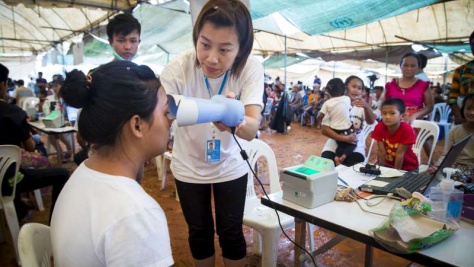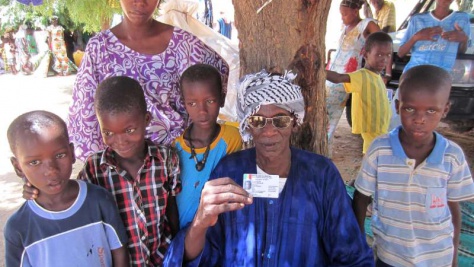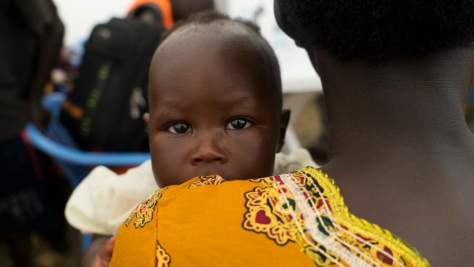Afghanistan: Iris-testing proves successful
This is a summary of what was said by UNHCR spokesperson Ron Redmond – to whom quoted text may be attributed – at today's press briefing at the Palais des Nations in Geneva.
Since we introduced state-of-the-art iris recognition tests for refugees seeking assistance to return to Afghanistan a year ago, we have so far seen more than 200,000 Afghans undergo what has proven to be a highly successful means to verify the identities of returnees. The use of the biometric data - unique to each eye - allows us to detect anyone who has previously been “enrolled” in the data base and is trying to seek assistance for a second time, which is not allowed. So far, the system has detected approximately 1,000 people who have tried to claim assistance for a second time. This is in addition to more than 70,000 families that were rejected last year under other screening methods, including more than 20,000 who were trying to recirculate through the system a second time.
Since a successful test project last October in Peshawar, some 202,000 refugees seeking UNHCR assistance under the voluntary repatriation programme have been checked. In July this year we have lowered the age of those tested to six years to ensure children are not being forced to make repeated trips with various adults - an abuse of the assistance programme and a danger to the children. Only those with physical impediments or who are too young to use the equipment are exempt.
This is the first field-use of such non-intrusive technology anywhere in the world. It has performed flawlessly despite the harsh conditions in the heat and dust of Pakistan’s border territories with Afghanistan. In addition to fixed locations, UNHCR is operating the equipment with mobile units to ease the return of refugees from remote areas. The actual enrolment process takes only a few seconds from when the returnee sits in front of the camera. Images of the iris, which appear on an adjoining computer screen, are transmitted to the computer server. The system converts the image into a digital code, which is then checked against the entire data base from all of our iris centres to see if there is a duplicate. If the code has not appeared before, the refugee is registered and given clearance to receive an assistance package on arrival in Afghanistan. Returnees are entitled to a travel grant that varies with the distance, several months of WFP food aid and some non-food items like shelter material. If the test reveals that the refugee has been enrolled before - and only about half of one percent are found to be “recyclers” - the person is refused assistance.
No information is recorded that can identify the individual tested - the code describing the iris has no link to the name, age, destination or anything else about the refugee. Since we began facilitating the return of Afghan refugees in early 2002, more than 2.4 million refugees have gone back, including more than 320,000 returnees from Pakistan so far this year.
Meanwhile, UNHCR this week organized the first convoy of internally displaced people returning from southern Afghanistan’s Kandahar Province back to their homes in the north. Thirty-six families (189 people) left Kandahar on Monday in 11 vehicles and yesterday reached their villages of origin in Morghab and Gormash areas in Badghis province, in north-western Afghanistan. The returning families will receive agricultural kits (seeds, shovel, sickle, watering can), plastic sheets, tents, lanterns, soap, hygiene cloths, family kits from UNICEF (spoons, bucket, cups, soap, bowl and plates) and WFP wheat flour.
Many of these families fled Badghis nearly two years ago and were staying in Zhare Dasht settlement or makeshift camps in Kandahar. They are all Pashtuns who had been harassed out of their homes following the fall of the Taliban or were caught in factional fighting.
Many more families have expressed their wish to go home this year, but UNHCR could not facilitate their return while fighting was ongoing in Badghis province earlier this year. With tension between factions subsiding in that region and an easing of the tension and drought conditions, UNHCR has begun helping since summer many displaced people to return to Badghis province, mainly from camps to the west in Herat.
UNHCR hopes to continue the voluntary return movements from the south to the north, but there are still specific areas in the north that we cannot recommend due to ongoing conflict between factions or human rights abuses.
There is an estimated 220,000 internally displaced people in Afghanistan, including some 140,000 in the southern provinces.
Related news and stories
Women-run businesses in Afghanistan dealt a blow by deepening restrictions
UNHCR launches new appeal for Afghan refugees and hosts, urging partners to stay the course
I had to flee for my education, but refused to leave other Afghan girls to their fate
Former refugee, now volunteer teacher, helps other Afghan girls get an education
Families struggle for survival during Afghanistan’s coldest winter in a decade
Afghan women affected by Taliban bans on work and study fear for their futures
Your search for « biometric » matched 879 results. Displaying page 1 of 98 pages.
-

Biometric Identity Management System
11 Mar 2015 ... Telecommunications (DIST) completed development of UNHCR’s new biometric identity management system (BIMS), building on the successful use of biometrics across a number of UNHCR operations globally. ...... -

UNHCR's new biometrics system helps verify 110,000 Myanmar refugees in Thailand
30 Jun 2015 ... refugees from Myanmar with the help of UNHCR's new biometrics identity management system (BIMS). ... "Biometrics will help refugees in the future as it ensures that once they've been through the system ...... -

UNHCR pilots new biometrics system in Malawi refugee camp
22 Jan 2014 ... has completed initial testing of a new biometrics system that should help it better register ... with the aim being to produce a biometrics system for the refugee agency that is fast, ...... -

Uganda starts biometric verification of refugees
2 Mar 2018 ... its launch of a countrywide biometric data verification to fix any discrepancies in refugee data. ... UNHCR, working with partners, will be expanding the biometric verification exercise, deploying more ...... -

UNHCR distributes biometric ID cards to refugees in Senegal
22 Oct 2012 ... she went to pick up her new biometric identity card from the UN refugee agency. "Finally I have it! ... to provide digitized and biometric ID cards to some 19,000 refugees by the end of this year. ...... -

Uganda starts biometric refugee verification
2 Mar 2018 ... With support from UNHCR, the UN Refugee Agency and partners, the government of Uganda launched the massive exercise on Thursday, March 1. The biometric data verification will assist the government to ...... -

Uganda launches major refugee verification operation
2 Mar 2018 ... programme on Thursday to verify the identities of all refugees in the country, using biometric data. ... The government is using UNHCR’s biometric registration software, which has already been used to ...... -

Registration and Identity management
... including support for digitalization, biometrics and other relevant technology, as well as ... PRIMES is comprised of several repositories for personal data (biographic and biometric) and ...... -

Iris scan system provides cash lifeline to Syrian refugees in Jordan
23 Mar 2015 ... AMMAN, Jordan, March 23 (UNHCR) - Sitting in the cold, windowless basement of an apartment block that he shares with his wife and two young children in Amman, Abu Ahmad describes himself as “one of ......
